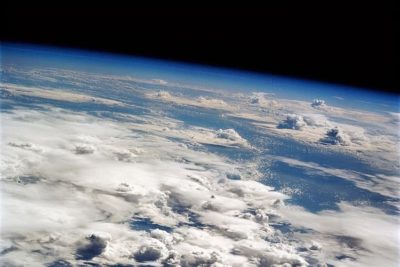Kármán Line: The Hypothetical Line That Delineates the Earth’s Atmosphere from Outer Space
Share

Photo of earth from International Space Station. (NASA / ISS043-E-86375)
The Kármán line is a hypothetical boundary located 100 km above sea level, designating the end of the earth’s atmosphere and the beginning of outer space. It is named after the Hungarian scientist Theodore von Kármán. He suggested its creation for the clear-cut separation of the fields of aeronautics and astronautics.

Theodore von Karman. (Theodore von Karman / Flickr)
Understanding the Earth’s atmosphere
The earth’s atmosphere is what we commonly call air, a dense mixture of gases whose physical properties affect everything moving within it. As you move up from the earth’s surface, the density of the air progressively decreases to eventually meld into the vacuum of outer space. There is no definite boundary where this happens. Experts estimate the distance to be between 100,000 km and 190,000 km above the earth’s surface. This area is the last layer of the atmosphere and is called the exosphere. The layer below this is called the thermosphere, which is between 500 km and 1,000 km above the earth’s surface. The mesosphere extends from a height of 50 km to 85 km; the air here is too thin to breathe. The stratosphere extends from 10 km to 50 km above the ground. The lowest layer with a height of about 10 km is called the troposphere. We live in this layer and the formation of clouds occurs here. Scientists defined the boundaries of these spheres at the points where there are discernible changes in the temperature of the air.
Satellites in the Earth’s atmosphere
Satellites orbit the earth at distances ranging from 160 km to 36,000 km above the earth’s surface. The International Space Station orbits at around 400 km. The Hubble Space Telescope orbits at 569 km. All these distances are within the earth’s atmosphere, but we talk about them orbiting in space as the atmospheric conditions at those distances have a negligible effect on their operation. So, the vehicles used to travel to the International Space Station and to repair satellites are called spacecraft and the people travelling in these vehicles are called astronauts.

Hubble Space Telescope. (NASA Hubble Space Telescope / Flickr)
Airplanes flying in the Earth’s atmosphere
An aircraft moves relative to the air and that movement is what enables its wings to generate the lift necessary to keep it flying forward. Passenger jets usually fly in the lower part of the stratosphere as the airflows there are less turbulent than in the troposphere. If they fly higher up into the mesosphere, they have to increase their speed to generate the necessary wing lift in the thinning air. Above the mesosphere, there is not enough air to provide any lift to an aircraft’s wings and it is pulled downwards by gravity. To stay aloft, the aircraft would have to increase its speed to touch orbital speed and then would have to follow the earth’s curvature.
The Kármán line
So, the highest distance above the earth’s surface where there is enough air for an aircraft to get the wing lift to fly in a straight line is considered by some people to be the end of the atmosphere.
Theodore von Kármán calculated this distance to be around 83 km and suggested that the value be rounded up to 100 km to make it easier to remember. The Fédération Aéronautique Internationale (FAI), the governing body for air sports, maintains separate records for air sports and space flights. It uses the Kármán line to differentiate between the two. However, not all countries and organizations are in unanimous agreement on the location of the Kármán line. Some countries consider the distance to be 50 km above the earth’s surface and other countries consider the distance to be 80 km.
The importance of the Kármán Line
Just as a country’s territorial rights extends for about 22 km in the surrounding seas and oceans, beyond which distance oceans are considered international waters, a country’s territorial rights also extend upward into the atmosphere. Hence, it is necessary to have something like the Kármán line to delineate airspace governed by each country from outer space over which no country can claim sovereignty. All countries have rules and regulations for passenger aircraft flying in their airspace.
Private space exploration companies, who are developing passenger spacecrafts, would have to know the distance above which they can fly to avoid this jurisdictional area. Another issue is whether these passengers can call themselves astronauts. There are countries that are opposed to defining a boundary for military reasons, and there are some countries that want a definite boundary for the same reason. Fighter aircrafts and missiles, which can travel higher than passenger aircrafts, could fly through sovereign airspaces, provoking military aggression.
There are satellites in low elliptical orbits whose distance from earth varies, based on their position. The closest distance is called perigee, and, for some satellites, this distance is below 100 km. Are the satellites sometimes orbiting in space and sometimes in the atmosphere?
National space institutions as well as private research institutions launch satellites for various purposes. What are the laws that should be applied if there are any disputes over the use of satellites while passing through national airspace?
There are some international rules and regulations for operating in what is considered outer space, and, so far, there have been no problems because of the lack of a definite boundary where this outer space begins. But that does not preclude issues from arising in the future as there is an increase in space exploration and space utilization activities.
Enjoyed this article? Also, check out “The Wallace Line: The Invisible Line of Bio-Diversity in the Indian Ocean“.
Fact Analysis:
STSTW Media strives to deliver accurate information through careful research. However, things can go wrong. If you find the above article inaccurate or biased, please let us know at [email protected]













